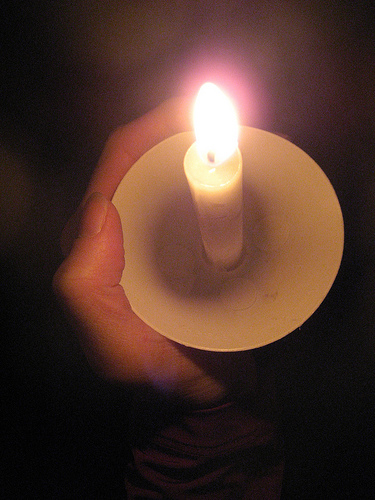Lent is the time when the church/congregation calls its people to live sacrificially in order to deepen faith. Jesus is held up as a model of this faith building life found in sacrifice. The congregation fills the role as an impartial intermediary in this Lenten exercise. Jesus sacrifices, the faithful sacrifice, the congregation observes and advises.
There is an element missing here which is at the heart of the stewardship of life which builds faith. Whatever happened to the call for the whole of the congregation to share in sacrifice? If Jesus is to model sacrifice and the people are to model Jesus, why is the congregation exempt? How can the members be asked to do what the congregation is not doing?
Years ago I received a lesson in how all this works together. Our congregation held a communion service on the first Sunday evening of each month. Once there were many who attended this service but in time the attendance fell to one elderly lady and the pastor.
Month after month the pastor conducted an abbreviated Eucharistic service for this lady. One night the treasurer of the congregation happened to be passing the building and noted the lights were turned on, so he stopped to turn them off and found himself in the middle of the worship service. He expressed his dismay at such a poor stewardship of the pastor’s time and the resource of the congregation.
At the next council meeting the treasurer moved that the council vote to discontinue this worship service. He noted that there were more than 85 light bulbs burning, six candles lighted at the altar, the pastor had to give more than one hour of his time after an exhausting day of work and the offering from this lady was so little that it did not even begin to cover the cost of unlocking the door. If we are to persuade the people to contribute to the church, first we would have to prove that we knew how to handle the little that they gave us.
There was a long silence at the end of his presentation and the council president then asked me to tell why I hadn’t come to them months before to resolve this problem. So, I related the following:
“Years ago, Maria Gonzalez de Bonaventura was a faithful member of the parish. But 40 years ago, her husband retired and they moved further out to the suburbs and no one remembers her. He was now 93 years old and could be left alone only after he went to bed at dusk. She was 80 and had no other family to care for him. So, once a month, even in the cold, dark of winter, she would leave her home at dusk, walk five blocks to the commuter train station and ride for more than an hour to the train station in our neighborhood. Then she would walk three blocks to our church to worship and receive the communion.
“After the service she would have the long ride home, arriving after 9 p.m. I offered to bring the sacrament to her home but she would not have it since it was not the same as going to church. The train fares to and from worship were four times her offering — but in relation to the tiny pension of which they lived, this excursion to worship costs a fortune.”
Again, there was silence. Finally, the president looked at the rest of the council and said, “We will not vote on this, Pastor, turn on all the lights, burn all the candles and keep the door open. Jesus said ‘where one or two are gathered in my name,’ Jesus did not say anything about what it cost. What we give to make this happen is very little compared to what she is giving to come to the church. We have to be here for her.”
On that night, the members of that council discovered the key to their future growth as a congregation.
They learned that the ministry of the congregation could not be measured in terms of what they were receiving as sacrifices from the members. It had to be understood in terms of what the congregation itself must be giving to the members. This had to come first in clearly demonstrable acts by the leaders of the congregation. If the leaders were not willing to use the authority and power of the church in giving to the members, then the members would naturally model themselves after their church.
They also learned that the values which were valid in one setting could not be applied in a faith setting. The lessons about values taught to us come from the immediate needs of those we are called to serve.
We shall never know the true meaning of being faithful stewards until we are prepared to risk the transitory for the sake of the ethereal. In other words, there has to come a time when we are willing to turn on all the lights and burn all the candles for the sake of the least of these.
On that night, the least known member of our congregation led us all by her example of faith. We learned that sacrifice must be a way of life for the congregation as well as the individual members.
(Photo by allegri used under Creative Commons License. Thanks!)
© Copyright 1997, Evangelical Lutheran Church in America.
This essay first appeared in the Spring 1997 issue of Faith in Action. Articles in Faith in Action may be reproduced for use in ELCA and ELCIC congregations provided each copy carries the note:
© Copyright 1997, Evangelical Lutheran Church in America. Reprinted with permission.




Leave a Reply